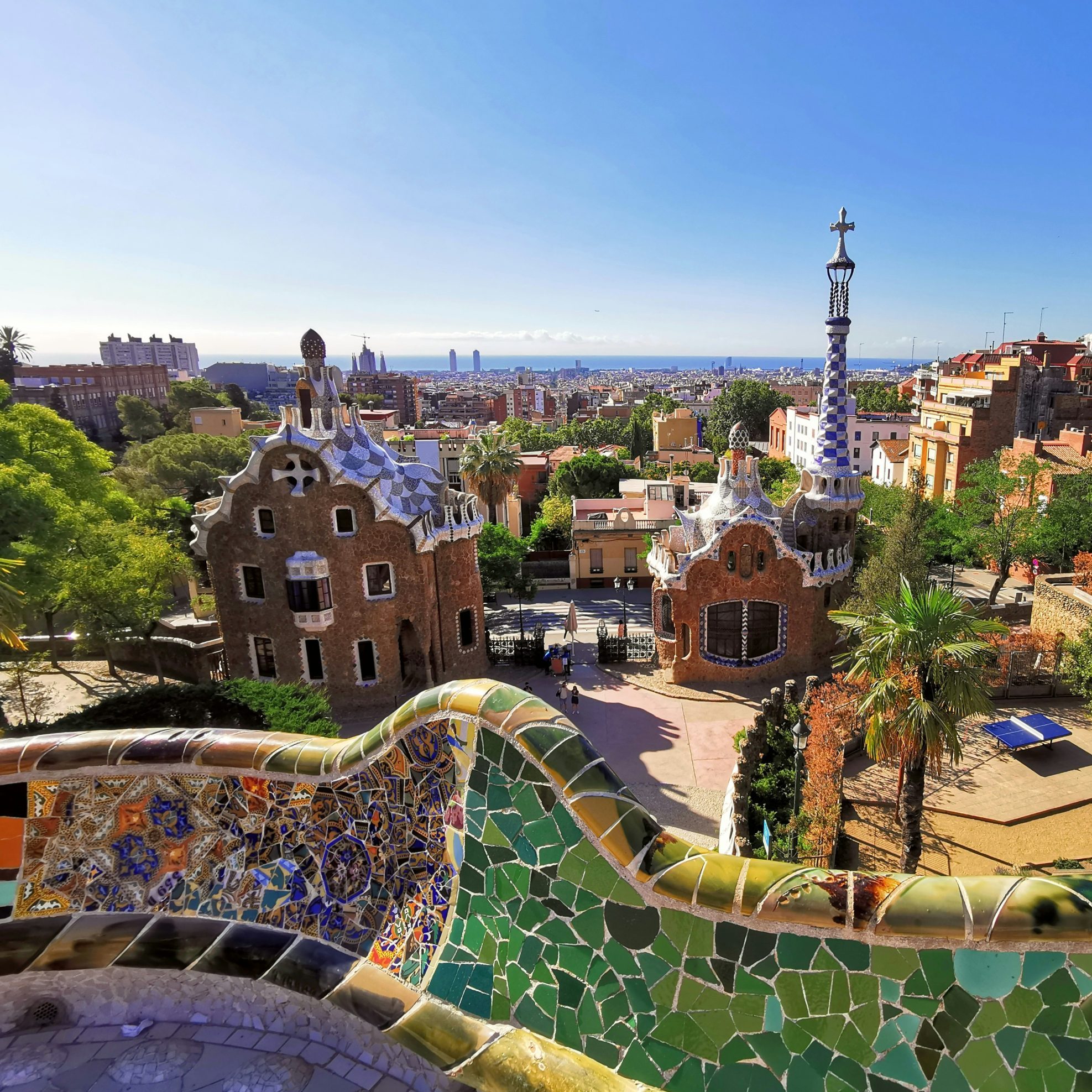El Doble, a bar in the Chamberí neighborhood. Photographer: Elena del Estal for Bloomberg Businessweek
A guide to Spain’s capital city, whose 24-hour buzz and artistic creativity make it a paradise for eaters and strollers.
September 27, 2023, 3:10 AM UTC
Introducing Two-Night Minimum, a series of city guides for those who want to get to the heart of a place in a short time—whether it’s on a business trip or a weekend vacation. First up: Madrid.
In Spain, Barcelona has long reigned supreme for all things culture and cool, while Madrid, the capital, has kept a reputation as the staid seat of banking and government. Not anymore. The arrival of wealthy transplants from across Latin America—many looking for a second home during the pandemic—has juiced foreign investment, creating a greater (and more international) audience than ever for a new wave of luxury hotels, global cuisines and hip bars and cafes.
Those who come here now, perhaps to do business with the fast-growing number of local tech startups and investment firms, will find a city with newfound confidence and swagger. Madrid has always seen itself as architecturally modern for Europe—most of its buildings, including the often-photographed Plaza Mayor, date back fewer than 200 years. Now it has the urban sophistication to match.
Related: Check out more at Bloomberg Travel, a new vertical for globetrotting leaders covering everything from the business of travel to the most worthwhile experiences that money can buy.
At its core, Madrid is a city unlike any other European capital. Paris has the Seine, London has the Thames—but can you name the river that flows through Madrid? Likely not. (It’s the Manzanares.) That’s because the hub of the city is instead a bustling public square, the Puerta del Sol, or “Gate of the Sun,” from which a radial network of boulevards and highways reach across the country and beyond. Only now, after 500 years as the Spanish capital, does it finally feel as though all roads do indeed lead to Madrid.
Here’s a cheat sheet to help you make the most of your visit, whether you have two nights or two weeks.
Top Rooms in Town
The details you really need to know to stay in comfort


Book It on Points: Santo Mauro
Sip tea or vermouth with the ladies who lunch at this maximally styled Luxury Collection hotel, which was once a ducal palace. It’s a great bet for Marriott Bonvoy junkies.
All-Day Dining
The local food lingo—and our favorite restaurants for every meal
Madrileños typically opt for a light midmorning bite instead of an elaborate breakfast—then they sneak in a noontime aperitivo (snack and drink), since lunch happens around 2:30 p.m. Post-siesta sugar fixes, or meriendas, take place around 5 p.m. Early-evening drinks are next, followed by dinner after 9.

A tortilla from Casa Dani. Photographer: Casa Dani
● Mercado de la Paz
The neighborhood market is an essential part of a Madrileño’s routine, and despite Salamanca’s surge in luxury condos and ritzy boutiques, its mercado remains resolutely traditional—except for placards promising two-hour delivery to locals via Amazon Prime. Fashion a superlative meal from the booths inside: The thick, wedge-cut omelet (they call it tortilla) at Casa Dani is easily the city’s best, as is the thin, knife-cut jamón at La Boulette.
● Tapas in Malasaña
You can easily undertake a drinks-and-snacks tapas crawl in any of Madrid’s neighborhoods, but none is as fun as punk-rock Malasaña, where younger locals converge on the scattering of vinyl shops, espresso bars (try Toma Café) and late-night dives. The route is simple: Start at Bodegas el Maño, hit up Casa Macareno and add a few extra stops of your own before winding up at Bodega de la Ardosa—all century-old establishments where cañas (small draft beers) and tintos de verano are liberally poured and jamón, croquetas and anchovies are doled out in equal measure.

A cocktail at Salmon Guru. Source: Salmon Guru
● Salmon Guru
Looking like the inside of a manga comic book, this beloved hangout is often credited as Madrid’s first gastronomic cocktail bar—and a major force behind the transformation of Barrio de las Letras. (More on that in the neighborhoods section.) The Asian-inspired menu is a welcome shift from Spanish staples, but watch out: An early-evening drink can easily turn into an hourslong experience as you gorge on fresh nigiri, nori tacos and ginger-glazed pork skewers before inevitably missing your dinner reservation.
● Garelos
Spaniards are fiercely loyal to their regional cuisines, but everyone’s in agreement—no matter where they’re from—that Galician dishes rank among the country’s most delicious, and Garelos’ perfected seafood standards are proof. The casual surroundings—graffitied cartoons on the walls and mismatched chairs—on an unpretentious block in Chamberí keep diners’ focus squarely on the dishes. Start with pan-fried chipirones (small squid), then go for zamburiñas (scallops) and octopus poached in rich olive oil. You’ll dream about the cloudlike cheesecake for weeks.

The dining room at Leña. Photographer: Hyatt Regency Hesperia Madrid
● Leña
You could fill a whole itinerary with Andalusian chef Dani García’s restaurants: His spots are a constellation of Michelin stars. Of them all, we prefer the moody, subterranean Leña, a Spanish steakhouse where Caesar salad is made tableside with fresh anchovies; foie gras, meanwhile, is disguised to look just like a Granny Smith apple. Sirloin gets an aromatic hit from a smoke gun—the same technique that makes charred pineapple sing at dessert.
● Take It Home: La Duquesita
Society women come to this buttoned-up bakery and cafe near the Chueca neighborhood for meriendas; we love it as a last stop before the airport. Get a milky coffee and croissant dunked in chocolate and sprinkled with pistachios—plus a dozen handmade bonbons wrapped up in a Tiffany-blue box. The raspberry and fig are especially divine.
On the Town
Activities to squeeze into any schedule
● El Rastro Remix
Considering the late hour at which Spaniards eat dinner, the most miraculous aspect of El Rastro, Madrid’s sprawling flea market near the Plaza Mayor, is witnessing just how many people are awake on a Sunday morning to rummage through dusty garage-sale castoffs. Skip the mosh pit of bargain hunters, and head to the area during the quieter weekdays to explore two stately shopping arcades—Galerías Piquer and Nuevas Galerías del Rastro—for a properly curated assortment of homewares and antiques. Plan to buy hand-embroidered napkins and coasters, many with tropical plant themes, at From:BEA, and painted ceramics or one-of-a-kind bird figurines at Cocol. Stave off any mid-shopping hunger pangs with sardine tapas at Bar Santurce or cinnamon rolls at Novo Mundo.
● Trade Flamenco for Spanish Guitar
Dozens of venues in town promise flamenco shows, but the tradition is best enjoyed in Andalucia, where it originated. For something more broadly Spanish—and without an audience made up entirely of tourists—consider a guitar show instead. The Sociedad Española de la Guitarra and Guitarras de Luthier, the country’s largest guitar shop, both run a well-vetted monthly calendar of performances; luxury travel agency Madrid & Beyond also arranges private performances.

The Estanque Grande del Retiro in Madrid. Photographer: Unaihuiziphotography/Getty Images
● A Walk in the Park
The perfect walking route through Parque de El Retiro, Madrid’s Central Park, starts at Puerta de Alcalá, the arched monument at the northwestern corner. From there, head past the fountains and geometrically planted flower beds until you reach El Estanque Grande, filled with rentable boats. Loop around the basin, taking in the stone colonnade and lion statues, and exit on the park’s easterly side, where a pedestrian median abuts Calle de Ibiza. Soon you’ll be in the heart of Barrio Ibiza, a family-friendly area full of orange and magenta apartment buildings. A refuel awaits at Taberna Laredo, where a Guernica-inspired mural is the backdrop to excellent mushroom risotto and tempura shrimp.
● The Prado, Abridged
There are more than 1,800 works on display at the Museo Nacional del Prado—of which 39 are recommended in the CliffsNotes-like guides at the reception desk. Let us narrow that down to three essential stops that illuminate Spain’s complex history: Gallery 12, containing Diego Velázquez’s striking royal portraiture (not to mention Las Meninas); Antonio Gisbert’s indelible Execution of Torrijos and His Companions on the Beach at Málaga; and the haunting collection of so-called Black Paintings by Francisco Goya.
Neighborhoods to Know
Half-day guides to two areas you should hit: One central, and one worth the (short) detour
Left: bars and restaurants in Barrio de las Letras. Right: the Chamberí neighborhood. Photographer: Elena del Estal for Bloomberg Businessweek
● Barrio de las Letras
Once a notorious hangout for prostitutes, this area has bars and boutiques in two broad categories: old establishments keeping Madrid’s yesteryear glamour alive and new ones expanding the city’s point of view. Check out the gardens at Casa Museo Lope de Vega, the eponymous writer’s 16th-century home, then sample traditional turrón (nougat) at Casa Mira. Wash it down with a Pisco cocktail at Gran Hotel Inglés, the city’s oldest hotel, or a glass of sherry at La Venencia, a legendary bar with dark wooden paneling and a strictly upheld no-photography rule. For dinner, time-travel to hypermodern Madrid with a bowl of thin-noodle hakata tonkatsu at the Chuka Ramen Bar next door, or sample global cuisine served on polished marble countertops at Galería Canalejas Food Hall beneath the turreted Four Seasons Hotel Madrid. Upstairs, Dani García goes molecular at his plant-filled perch, Dani.
● Chamberí
More a borough than a neighborhood in terms of sheer size, Chamberí was home to Castilian blacksmiths during the 19th century. It’s now an elegant grid of grand residential blocks just beyond bustling Malasaña and Chueca. Start with the paintings of celebrated Spanish impressionist Joaquín Sorolla at Museo Sorolla, easily Madrid’s best small museum and the artist’s former home. Grab a bite afterward at the Mercado de Chamberí—part food hall, part traditional grocer. It’s tapas central on Calle de Ponzano, which has fast become a beloved culinary corridor for Madrileños; try the trendy Sala de Despiece with its futuristic butcher-shop vibe. And if you wear out your shoes from exploring, score a new pair at Antigua Casa Crespo, which has kept the tradition of hand-weaving espadrilles alive for almost 200 years. Pick up some retuerta cheese from Formaje and a bottle of Spanish wine at Vino & Cia. near the spouting fountains and Juliet balconies of Plaza de Olavide.
Extend Your Trip
Adventures beyond the city limits

The old town of Toledo. Photographer: Lamberto Jesus/Getty Images
A cluster of medieval towns lies within Madrid’s orbit. Toledo, with its splendid cathedral and museum honoring the soul-stirring painter El Greco, is only 35 minutes away by train and is the easiest to tackle in a day. For a longer escape, rent a car and head to the beautiful village of Pedraza, 90 minutes away. Base yourself at the five-room, 17th century Casa Taberna—it’s owned and operated by celebrity chef Samantha Vallejo-Nágera and puts you within a half-hour drive of the aqueducts and castle spires of Segovia.
One More Thing
A final tip before you’re on your way
The Michelin agenda is antithetical to the dining experience of Madrid—a city whose social scene is built upon tapas. These sometimes complimentary bites of food (also called pinchos or raciónes, depending on size or provenance), which accompany alcoholic beverages, are by definition unpretentious and casual.
So instead of following guidebook stars, take this as a general rule: The worse the napkin quality, the better the grub.










